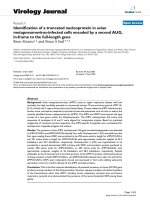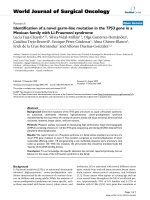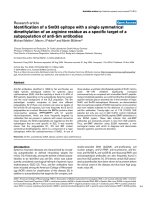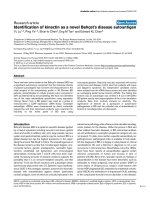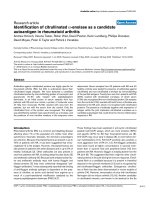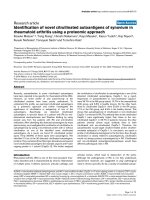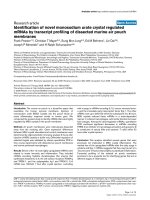Báo cáo y học: " Identification of a novel betaherpesvirus in Mus musculus" docx
Bạn đang xem bản rút gọn của tài liệu. Xem và tải ngay bản đầy đủ của tài liệu tại đây (229.78 KB, 4 trang )
BioMed Central
Page 1 of 4
(page number not for citation purposes)
Virology Journal
Open Access
Short report
Identification of a novel betaherpesvirus in Mus musculus
Alla Teterina
1
, Dania Richter
2
, Franz-Rainer Matuschka
2
, Bernhard Ehlers
1
and Sebastian Voigt*
3
Address:
1
Research group "Molecular Genetics and Epidemiology of Herpesviruses", Robert Koch Institute, Berlin, Germany,
2
Institute for
Pathology, Charité Universitätsmedizin Berlin, Berlin, Germany and
3
Division of Viral Infections, Robert Koch Institute, Berlin, Germany
Email: Alla Teterina - ; Dania Richter - ; Franz-Rainer Matuschka - franz-
; Bernhard Ehlers - ; Sebastian Voigt* -
* Corresponding author
Abstract
Rodent betaherpesviruses vary considerably in genomic content, and these variations can result in
a distinct pathogenicity. Therefore, the identification of unknown betaherpesviruses in house mice
(Mus musculus), the most important rodent host species in basic research, is of importance. During
a search for novel herpesviruses in house mice using herpesvirus consensus PCR and attempts to
isolate viruses in tissue culture, we identified a previously unknown betaherpesvirus. The primary
PCR search in mouse organs revealed the presence of known strains of murine cytomegalovirus
(Murid herpesvirus 1) and of Mus musculus rhadinovirus 1 only. However, the novel virus was
detected after incubation of organ pieces in fibroblast tissue culture and subsequent PCR analysis
of the supernatants. Long-distance PCR amplification including the DNA polymerase and
glycoprotein B genes revealed a 3.4 kb sequence that was similar to sequences of rodent
cytomegaloviruses. Pairwise sequence comparisons and phylogenetic analyses showed that this
newly identified murine virus is most similar to the English isolate of rat cytomegalovirus, thereby
raising the possibility that two distinct CMV lineages have evolved in both Mus musculus and Rattus
norvegicus.
Findings
Cytomegalovirus (CMV), a member of the Betaherpesviri-
nae, can cause severe infections in immunocompromised
hosts. Because of their inherent species-specificity, CMVs
are used in rodent infection models to study human CMV
(HCMV) pathogenesis. These models include, e.g., the
house mouse (Mus musculus) and the rat (Rattus norvegi-
cus) with their host-specific viruses (mouse and rat CMV;
MCMV and RCMV, respectively). CMVs have evolved with
their hosts for a long period of time, and this coexistence
has shaped their genetic content. In addition, frequent
serial passaging of the commonly used MCMV laboratory
strains Smith and K181 has resulted in even further varia-
tions of viral genes and the emergence of new genotypes
[1-4]. This genetic variation, including the loss of numer-
ous genes, has been also reported for clinical isolates of
HCMV [5,6].
To determine the impact that the presence of modified or
completely different genes on CMV biology might imply,
we sought to detect novel betaherpesviruses. To do so, we
employed consensus PCR with degenerate primers that
had previously proven useful in identifying a hitherto
unknown gammaherpesvirus, the first reported rhadino-
virus in Mus musculus [7]. Spleens, lungs, inguinal lymph
nodes and salivary glands were obtained from two or
Published: 21 December 2009
Virology Journal 2009, 6:225 doi:10.1186/1743-422X-6-225
Received: 2 November 2009
Accepted: 21 December 2009
This article is available from: />© 2009 Teterina et al; licensee BioMed Central Ltd.
This is an Open Access article distributed under the terms of the Creative Commons Attribution License ( />),
which permits unrestricted use, distribution, and reproduction in any medium, provided the original work is properly cited.
Virology Journal 2009, 6:225 />Page 2 of 4
(page number not for citation purposes)
three individuals of four strains of house mice. Each organ
sample was divided into two pieces, one for DNA extrac-
tion followed by an initial PCR analysis with degenerate
consensus primers and one for virus isolation in fibroblast
tissue culture. The organ samples were minced and co-cul-
tivated on monolayers of murine 3T3 and 10.1 cells, as
well as on L929 and BHK21 cells. About two weeks later,
supernatants were taken, DNA was extracted, and another
PCR analysis was performed using the same primers as in
the initial analysis. DNA of organs and tissue supernatants
was extracted using the QiAamp tissue kit according to the
manufacturer's instructions (Qiagen, Hilden, Germany).
Panherpes consensus-PCR for amplification of a 160 bp -
181 bp fragment (without primer-binding sites) of the
DPOL gene [8] was carried out with five degenerate/deox-
yinosine-substituted (deg/dI) nested-primers as described
previously [9] (Figure 1).
Direct consensus PCR analysis of 44 organ samples col-
lected from eleven mice of four house mouse strains
revealed the presence of several variants of MCMV in two
mouse strains and of the previously described Mus muscu-
lus rhadinovirus 1 (MmusRHV-1 [7]) in one strain. Subse-
quent PCR analysis of tissue culture supernatants of
MCMV-positive organs confirmed known MCMV in all
cases. The tissue culture supernatants of MmusRHV-1-
positive organs, however, did not contain the expected
sequences, indicating that MmusRHV-1 failed to grow in
cell culture. Instead, we detected a DPOL sequence of an
unknown betaherpesvirus in the supernatant of L929 cells
that had been co-cultivated with the MmusRHV-1-posi-
tive lung (specimen #5479) of one mouse (Figure 2a).
To amplify glycoprotein B (gB) gene sequences of that
virus, the deg/dI nested-primer set CMV-gB-1 was used
(Figure 1a). With this set, gB gene sequences of several
members of the Betaherpesvirinae subfamily had previ-
ously been amplified, resulting in a second-round ampli-
fication product of approximately 225 bp (without
primer-binding sites) [7]. PCR products were obtained
from the L929 tissue culture supernatants, and sequenc-
ing revealed a gB sequence of an unknown betaherpesvi-
rus.
To prove that the gB and the DPOL sequence originated
from the same virus, we connected them with Long-dis-
tance (LD) PCR using the TaKaRa-Ex PCR system (Takara
Bio inc., Otsu, Japan) according to the manufacturer's
instructions. An amplification product of approximately
3,3 kb size was obtained and sequenced by primer walk-
ing. A contiguous sequence of 3431 bp was obtained (in
combination with the initial gB and DPOL sequences),
spanning 1101 bp of the 3'-part of the gB gene and 2313
bp of the 5'-part of the DPOL gene (Figure 1a). Since a
cytomegalovirus of the house mouse is already known
(MCMV = MuHV-1), the virus from which the novel
sequence originated was tentatively named Mus musculus
cytomegalovirus 2 (MmusCMV-2).
Rowe and Capps [10] discovered a mouse virus which
causes thymic necrosis in newborn mice, however, it
could not be propagated in cell culture. This virus was
named mouse thymic virus (MTV) and classified as Murid
herpesvirus 3 (MuHV-3). No sequences of MuHV3 are
available in public databases. Seroepidemiological studies
have shown that MuHV-3 (like MCMV) is ubiquitously
present in free-living European house mice [11]. To rule
out that MmusCMV-2 might in fact be MuHV-3, we com-
pared it with a recently amplified partial DPOL sequence
of MuHV-3 (R. S. Livingston, University of Missouri-
Columbia, USA; personal communication). This 450 bp
betaherpesvirus-like sequence of MuHV-3 was only dis-
tantly related to the corresponding DPOL sequence of
MmusCMV-2 (and those of MCMV, RCMV-E and RCMV-
M) (data not shown). Therefore, we concluded that
MmusCMV-2 and MuHV-3 are different viruses.
From the DPOL sequence, we deduced primers specific for
MmusCMV-2 (MmusCMV2-fwd: 5' CGGCATGCTCCCTT-
GTCTTC-3'; MmusCMV2-rev: 5'TTGATGCGAAGGACT-
TCGGT-3'). The expected amplification product had a size
of 168 bp. With an annealing temperature of 60°C, all 44
organ samples were retested, using the MmusCMV-2-pos-
itive supernatant as a control. As expected, the cell culture
supernatant tested positive for MmusCMV-2 as did lung,
spleen, salivary gland and lymph node of that mouse
from which the positive supernatant originated. In con-
trast, the organs of all other mice were negative for
Amplification strategyFigure 1
Amplification strategy. At the top of the figure above the
ruler, the ORFs of UL55 and UL54 are represented by black
arrows. Below the ruler, the PCRs are depicted. The degen-
erate and specific primers are represented by black and open
triangles, respectively. Amplified sequences are shown as
black lines.
DNA polymerase gene (DPOL)Glycoprotein B gene (gB)
ORF UL55 ORF UL54
0 1 2 3 4 5 6 (kb)
Degenerate nested PCR Degenerate nested PCR
Specific nested long-distance
PCR
Contiguous sequence
Virology Journal 2009, 6:225 />Page 3 of 4
(page number not for citation purposes)
MmusCMV-2. Additionally, lung specimens of the
MmusCMV2-positive house mouse strain and of wild
house mice, caught in Lower Saxony, Germany, were
tested with the MmusCMV2-specific PCR. Two mice each
revealed amplification products of the expected size.
These were verified to originate from MmusCMV2 by
sequencing (data not shown).
To determine the evolutionary position of MmusCMV-2,
the 3421 bp sequence [GenBank: GU017485
] was pair-
wise compared with the corresponding DPOL and gB
sequences of MCMV (Murid herpesvirus 1; [GenBank:
NC_004065
][3,12]), RCMV Maastricht isolate (Murid her-
pesvirus 2; [GenBank: AF232689
][13,14]), RCMV English
isolate (RCMV-E; [GenBank: GU018179
]) and HCMV
(Human herpesvirus 5; [GenBank: AY446894
]). For
MmusCMV2, pairwise identity percentages were 57.6%,
56.2%, 65.9% and 46.9%, respectively (Table 1). There-
fore, we conclude that RCMV-E might be the closest rela-
tive of MmusCMV-2.
Multiple sequence alignments were then generated with
the complete 3.4 kb nucleic acid (NA)-sequence, and a
phylogenetic tree was constructed using the neighbour-
joining module of the MacVector™ software (version
10.6). In the tree, MmusCMV-2 branched with RCMV-E,
The novel cytomegalovirus of Mus musculus: Multiple sequence alignment and phylogenetic analysisFigure 2
The novel cytomegalovirus of Mus musculus: Multiple sequence alignment and phylogenetic analysis. (a) The
MmusCMV-2 DPOL sequence amplified by panherpes consensus PCR (178 bp) was translated into a 59 aa sequence, and a
multiple sequence alignment with the corresponding sequences of MCMV, RCMV-M, RCMV-E, HCMV and HHV-6b was gener-
ated using the ClustalW module of MacVector™ 10.6. Identical and similar amino acids are boxed, the last in inverse type. Mis-
matches are given in lower type. (b) A phylogenetic tree was constructed using the nucleic acid sequences encoded by the gB-
DPOL segments of MmusCMV-2 and those of known human, mouse and rat cytomegaloviruses (GenBank accession numbers
in the Findings section). Abbreviations of common names are used, and those of species names according to the ICTV (Interna-
tional Committee on the Taxonomy of Viruses) are given in parentheses. A multiple alignment of 3.4 kb was analysed with the
neighbour-joining method. A rooted phylogram is shown, with HHV-6a as outgroup. The branch length is proportional to evo-
lutionary distance (scale bar). Results of bootstrap analysis (1000 replicates) are indicated at the nodes of the tree. The novel
MmusCMV-2 is highlighted in bold type.
(a)
99
HHV-6a
RCMV-E
MmusCMV-2
MCMV (MuHV-1)
RCMV-M (MuHV-2)
HCMV (HHV-5)
0.1
100
99
99
(b)
Table 1: Percentages of nucleic acid identity
MmusCMV-2 RCMV-E MCMV RCMV-M HCMV HHV-6a
MmusCMV-2 100.0 65.9 57.6 56.2 46.9 50.1
RCMV-E 65.9 100.0 59.9 57.5 46.3 50.7
MCMV 57.6 59.9 100.0 66.8 54.2 47.4
RCMV-M 56.2 57.5 66.8 100.0 55.0 44.9
HCMV 46.9 46.3 54.2 55.0 100.0 41.6
HHV-6a 50.1 50.7 47.4 44.9 41.6 100.0
Publish with BioMed Central and every
scientist can read your work free of charge
"BioMed Central will be the most significant development for
disseminating the results of biomedical research in our lifetime."
Sir Paul Nurse, Cancer Research UK
Your research papers will be:
available free of charge to the entire biomedical community
peer reviewed and published immediately upon acceptance
cited in PubMed and archived on PubMed Central
yours — you keep the copyright
Submit your manuscript here:
/>BioMedcentral
Virology Journal 2009, 6:225 />Page 4 of 4
(page number not for citation purposes)
and MCMV (MuHV-1) with RCMV-M (MuHV-2) (Figure
2b). In parsimonial analysis with concatenated amino
acid (aa) sequences (367 aa of gB plus 771 aa of DPOL)
using the PARS module of the PHYLIP program package
on the Trex server
, MmusCMV-2
branched with RCMV-E and RCMV-M (MuHV-2) (data
not shown).
Our findings revealed that Mus musculus - like Rattus nor-
vegicus - harbours two distinct CMV (MCMV and
MmusCMV-2). The results of the pairwise sequence com-
parisons and the NA-based phylogenetic analysis showed
that this newly identified murine virus MmusCMV-2 is
most similar to RCMV-E. This raises the possibility that
two distinct CMV lineages in both Mus musculus and Rat-
tus norvegicus have evolved. At this point, however, we ten-
tatively state that MmusCMV-2 represents a distinct CMV,
as has been reported for RCMV-E and RCMV-M [15,16].
As soon as the virus has been cultured to sufficiently high
titres, the complete MmusCMV-2 sequence derived from
purified virus DNA may confirm its distinctiveness.
Further analysis of the molecular biology of MmusCMV-2
and the study of its behaviour in vivo might reveal signifi-
cant differences to MCMV and the two rat CMVs and
broaden our understanding of cytomegalovirus biology.
Abbreviations
BHK: baby hamster kidney; CMV: cytomegalovirus;
DPOL: DNA polymerase; gB: glycoprotein B; HCMV:
human cytomegalovirus; MCMV: murine cytomegalovi-
rus; MuHV-1: Murid herpesvirus 1; MuHV-2: Murid her-
pesvirus 2; MuHV-3: Murid herpesvirus 3; MmusCMV-2:
Mus musculus cytomegalovirus 2; MmusRHV-1: Mus mus-
culus rhadinovirus 1; RCMV: rat cytomegalovirus; RCMV-
E: English isolate; RCMV-M: Maastricht isolate.
Competing interests
The authors declare that they have no competing interests.
Authors' contributions
BE, AT, DR, FRM and SV designed research; AT performed
research; BE, AT and SV analysed data; and BE and SV
wrote the manuscript. All authors read and approved the
final manuscript.
References
1. Smith LM, Shellam GR, Redwood AJ: Genes of murine cytomega-
lovirus exist as a number of distinct genotypes. Virology 2006,
352:450-465.
2. Booth TW, Scalzo AA, Carrello C, Lyons PA, Farrell HE, Singleton
GR, Shellam GR: Molecular and biological characterization of
new strains of murine cytomegalovirus isolated from wild
mice. Arch Virol 1993, 132:209-220.
3. Smith LM, McWhorter AR, Masters LL, Shellam GR, Redwood AJ:
Laboratory strains of murine cytomegalovirus are geneti-
cally similar to but phenotypically distinct from wild strains
of virus. J Virol 2008, 82:6689-6696.
4. Corbett AJ, Forbes CA, Moro D, Scalzo AA: Extensive sequence
variation exists among isolates of murine cytomegalovirus
within members of the m02 family of genes. J Gen Virol 2007,
88:758-769.
5. Cha TA, Tom E, Kemble GW, Duke GM, Mocarski ES, Spaete RR:
Human cytomegalovirus clinical isolates carry at least 19
genes not found in laboratory strains. J Virol 1996, 70:78-83.
6. Murphy E, Rigoutsos I, Shibuya T, Shenk TE: Reevaluation of
human cytomegalovirus coding potential. Proc Natl Acad Sci
USA 2003, 100:13585-13590.
7. Ehlers B, Kuchler J, Yasmum N, Dural G, Voigt S, Schmidt-Chanasit J,
Jakel T, Matuschka FR, Richter D, Essbauer S, Hughes DJ, Summers C,
Bennett M, Stewart JP, Ulrich RG: Identification of novel rodent
herpesviruses, including the first gammaherpesvirus of Mus
musculus. J Virol 2007, 81:8091-8100.
8. Ehlers B, Borchers K, Grund C, Frolich K, Ludwig H, Buhk HJ: Detec-
tion of new DNA polymerase genes of known and potentially
novel herpesviruses by PCR with degenerate and deoxyinos-
ine-substituted primers. Virus Genes 1999, 18:211-220.
9. Chmielewicz B, Goltz M, Ehlers B: Detection and multigenic
characterization of a novel gammaherpesvirus in goats. Virus
Res 2001, 75:87-94.
10. Rowe WP, Capps WI: A new mouse virus causing necrosis of
the thymus in newborn mice.
J Exp Med 1961, 113:831-844.
11. Becker SD, Bennett M, Stewart JP, Hurst JL: Serological survey of
virus infection among wild house mice (Mus domesticus) in
the UK. Lab Anim 2007, 41:229-238.
12. Rawlinson WD, Farrell HE, Barrell BG: Analysis of the complete
DNA sequence of murine cytomegalovirus. J Virol 1996,
70:8833-8849.
13. Beuken E, Slobbe R, Bruggeman CA, Vink C: Cloning and sequence
analysis of the genes encoding DNA polymerase, glycopro-
tein B, ICP18.5 and major DNA-binding protein of rat
cytomegalovirus. J Gen Virol 1996, 77(Pt 7):1559-1562.
14. Vink C, Beuken E, Bruggeman CA: Complete DNA sequence of
the rat cytomegalovirus genome. J Virol 2000, 74:7656-7665.
15. Beisser PS, Kaptein SJ, Beuken E, Bruggeman CA, Vink C: The Maas-
tricht strain and England strain of rat cytomegalovirus rep-
resent different betaherpesvirus species rather than strains.
Virology 1998, 246:341-351.
16. Voigt S, Sandford GR, Hayward GS, Burns WH: The English strain
of rat cytomegalovirus (CMV) contains a novel captured
CD200 (vOX2) gene and a spliced CC chemokine upstream
from the major immediate-early region: further evidence for
a separate evolutionary lineage from that of rat CMV Maas-
tricht. J Gen Virol 2005, 86:263-274.

